Tokyo's Sagacho Says Sayonara
Sometimes you just have to bite the bullet; it's all part of the business, I suppose. But that doesn't mean I have to like it.
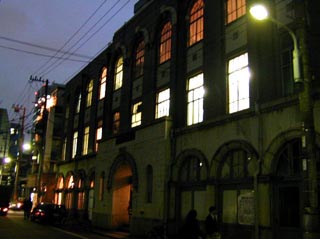 I'm talking about bad weeks. There are lots of them in the news game over the course of a year, and during these times anything and everything just seems to go wrong. As an example, take the events of this week thus far: a big story initially earmarked for my byline gets farmed out to a stringer at the last minute, a carefully crafted lead for another is completely reworked by a fickle editor, and then - in what is akin to having my own flesh filleted - a full feature is trimmed of its content by a third after hitting syndication.
I'm talking about bad weeks. There are lots of them in the news game over the course of a year, and during these times anything and everything just seems to go wrong. As an example, take the events of this week thus far: a big story initially earmarked for my byline gets farmed out to a stringer at the last minute, a carefully crafted lead for another is completely reworked by a fickle editor, and then - in what is akin to having my own flesh filleted - a full feature is trimmed of its content by a third after hitting syndication.
So, today at my desk I found myself waiting for the next act of injustice to fall, just tapping the brown top with the fingers of my right hand while simultaneously ticking off in my head the cheap underwear options available at various train station kiosks when it sure enough did:
"You damned lazy bum!"
But I must note that during weeks good and bad junior reporter Junko will somehow find herself positioned in my office doorway at some point.
She continued with the pleasantries, "Get the Sagacho story ready, you stiff!"
I tried my standard stall: "I still have to fact-check it first."
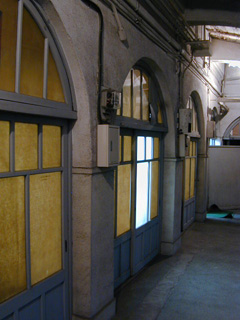 "Cut the funny business - you were likely much less than sober when you wrote it in the first place..."
"Cut the funny business - you were likely much less than sober when you wrote it in the first place..."
I smiled.
She folded her arms at her chest, "And letting you fact-check it is like letting a coked-up baboon inspect a hand grenade! Get it on my desk in an hour and I'll do it myself!"
She turned for her desk in the newsroom. I resumed my tapping.
Once "the Sagacho," as the locals simply referred to this 75-year old brownstone, is completely leveled, few will probably even notice the irony. Certainly not the building's neighbors in this sleepy semi-industrial area of eastern Tokyo bordering the Sumida River; nor either the future occupants of the new apartment building that will go up on the site next year.
Rather, other than the past exhibitors and guests of its galleries in recent years, it is likely that nobody will realize that the basic reason for its destruction is rooted in the very same consumerist principles which much of the art it housed cast commentary upon.
The process of scrap-and-build, a nearly Tokyo tradition since the end of World War II, will this time claim one of Tokyo's premier exhibit spaces for contemporary art. When the excavator has lowered its shovel for the final time in the coming months, all that will remain is yet another example of the mentality of new being superior to old, and an increasing reminder of just how tough it is to fight for preservation of cultural assets in Japan.
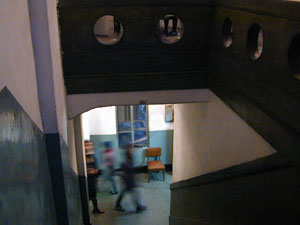 To be sure, the Sagacho Shokuryo Building (as it was exactly titled with "Sagacho" being the neighborhood's name) was not unique by European or American standards - its open courtyard could have easily been mistaken for that of a villa in Spain and its red brick exterior wouldn't have been out of place fronting a Harlem street - but in always evolving Tokyo, it was rare. And that gave it character and charm.
To be sure, the Sagacho Shokuryo Building (as it was exactly titled with "Sagacho" being the neighborhood's name) was not unique by European or American standards - its open courtyard could have easily been mistaken for that of a villa in Spain and its red brick exterior wouldn't have been out of place fronting a Harlem street - but in always evolving Tokyo, it was rare. And that gave it character and charm.
"I think the old nature of the building made it more effective to the visitor," explains Taro Nasu, head of Taro Nasu Gallery, one of four galleries exhibiting at its closing. "The building had a special atmosphere, which would take the visitor beyond the time when they shared the space with art there."
That "special atmosphere" included irregularities and aspects of architecture that just plain aren't utilized too often: a concrete staircase banister was sliced with circular holes; a hallway wall was formed with a series of arches filled with glass; a visitor opening one door might have entered an open room with a high ceiling, behind another might have been a closet or perhaps even the veranda overlooking the courtyard. The building had almost no traditional Japanese architectural influences. Quirks and a lack of symmetry were the norm, and appreciation for the holistic feeling garnered by it all might be best described as something similar to what a Red Sox fan in Boston feels for Fenway Park.
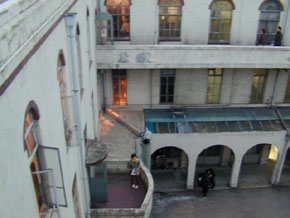 The Sagacho Exhibit Space got the artistic ball rolling in 1983 when it transformed the building from a rice trading house into a showcase for contemporary art. After funding trouble in 2000, the Sagacho Exhibit Space closed and new exhibitors moved in. In addition to those of Taro Nasu, the building, in its final days, hosted art culled from Tomio Koyama Gallery, and the joint collaboration of Gallery Koyanagi and Shugo Arts known as Rice Gallery, from where actual rice was sold.
The Sagacho Exhibit Space got the artistic ball rolling in 1983 when it transformed the building from a rice trading house into a showcase for contemporary art. After funding trouble in 2000, the Sagacho Exhibit Space closed and new exhibitors moved in. In addition to those of Taro Nasu, the building, in its final days, hosted art culled from Tomio Koyama Gallery, and the joint collaboration of Gallery Koyanagi and Shugo Arts known as Rice Gallery, from where actual rice was sold.
In the end, it was time that got the best of the structure, both inside and out; paint was peeling, windows had cracks, floor tiles were damaged. More importantly, though, the building was in need of seismic resistance improvements. The owner decided to sell it in favor of the construction of an apartment complex. But given recent land use trends in Tokyo, this was not all that surprising.
Tokyo is in the middle of yet another construction boom. In addition to massive office buildings poking through its downtown skies, old residential areas are increasingly adding new and modern housing facilities. For four straight years, the number of new condominiums put on the market in Tokyo has exceeded 80,000, according to a report released this year by the Real Estate Economic Institute, with the last two years having yielded two of the three highest totals in the last 30 years.
Preservation of historic buildings is an option for structures of historical importance, but not an easy one to accomplish. Though data compiled through early last year by the Ministry of Education, Culture, Sports, Science, and Technology indicates that roughly 2,500 buildings in Japan have been designated as cultural properties, priority tends to not be with preservation.
The first step is for the building, or any endangered cultural asset in general, to be protected under the Cultural Properties Preservation Law. However, in recent years, government recognition of cultural resources has been seemingly as swift as the rate of rust formation on the Sagacho's roof drainpipes.
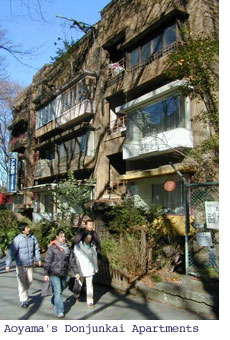 As an example, the Atomic Bomb Dome - the signature surviving structure from the atomic bomb dropped over Hiroshima in 1945 - had difficulty at first in being granted protection status in eight years ago because it was not seen as being old enough. Further, last year, the mayor of Toyosato in Shiga Prefecture defied a court order and ordered the commencement of the demolition, which was eventually halted, of an art deco building dating 1937 that is the home of an elementary school. Then later this year, the ivy-covered Dojunkai Apartments in Tokyo's Aoyama district - the last remaining buildings of a series of Western-style pioneer complexes that emerged in Tokyo in the 1920s - will meet the wrecking ball with world famous architect Tadao Ando supplying the design for a replacement housing complex that purports to be replete with today's latest living innovations.
As an example, the Atomic Bomb Dome - the signature surviving structure from the atomic bomb dropped over Hiroshima in 1945 - had difficulty at first in being granted protection status in eight years ago because it was not seen as being old enough. Further, last year, the mayor of Toyosato in Shiga Prefecture defied a court order and ordered the commencement of the demolition, which was eventually halted, of an art deco building dating 1937 that is the home of an elementary school. Then later this year, the ivy-covered Dojunkai Apartments in Tokyo's Aoyama district - the last remaining buildings of a series of Western-style pioneer complexes that emerged in Tokyo in the 1920s - will meet the wrecking ball with world famous architect Tadao Ando supplying the design for a replacement housing complex that purports to be replete with today's latest living innovations.
But Yokohama's Red Brick Warehouses project is proof that preservation of old structures is possible. Structural reinforcements were added to the nearly century-old brick structures to meet earthquake standards, and today restaurants, antique shops and gallery space occupy each of their two stories.
Though with art exhibits not being nearly as lucrative a revenue generator, the additions and various repairs necessary for the Sagacho were termed excessive. A company did step forward in the end to buy the building in order for it to be preserved as an art facility but, as Taro remembers, "everything went so fast for us that we finally decided to accept the reality [of demolition]."
As a grand sendoff, a special exhibition called "Emotional Site" was held late last year. The four galleries pulled out all the stops; nearly all of the building's rooms, large and small, were cleared and photographs, movies, paintings, and various other exhibits from the galleries' top artists were brought in for display.
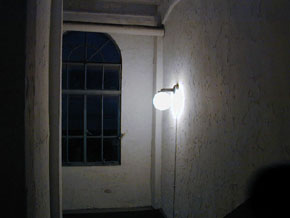 Promotional posters for the show featured a photo of an outside corner of the structure with a massive web of utility lines obscuring a clear view. The message was clear: Nothing can stop the encroachment of "progress" any longer.
Promotional posters for the show featured a photo of an outside corner of the structure with a massive web of utility lines obscuring a clear view. The message was clear: Nothing can stop the encroachment of "progress" any longer.
"I miss the building itself - the existence of it," says Taro of his vacating the property. His gallery will be moving to Roppongi with Shugo Arts, Gallery Koyanagi, and Tomio Koyama Gallery occupying a new space in Tokyo's Shinkawa district.
As one of the few buildings that survived the Allied bombings of World War II, the Sagacho is today surrounded with white protective barricades. Large chunks have already been knocked away from its frame and an information placard describes the details of the soon-to-be constructed 14-floor apartment building.
In looking at Tokyo's lack of priority given to preservation of historic buildings, Taro says, "When they have disappeared, I think we will then see what they were for us."

